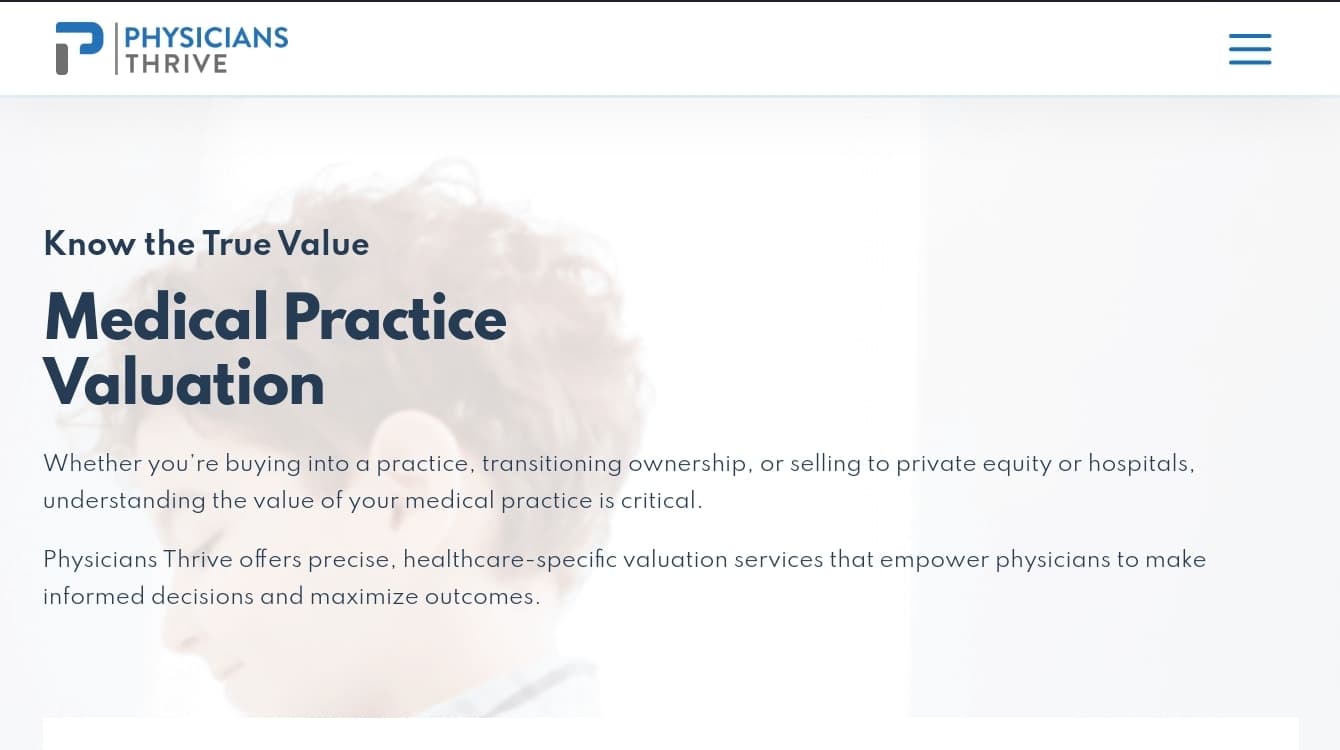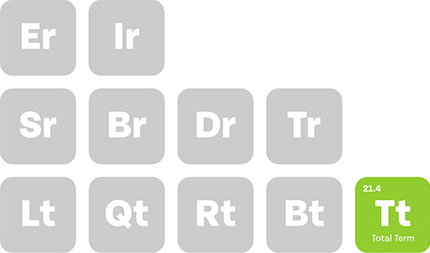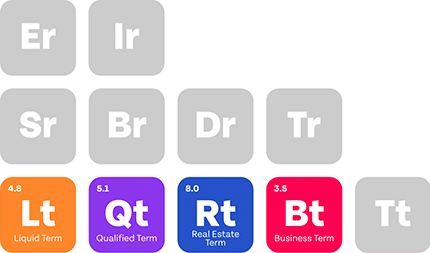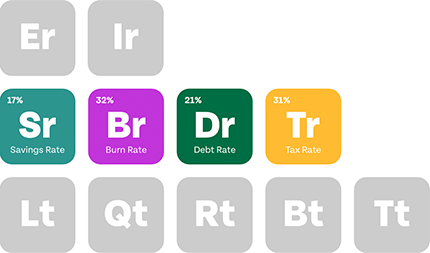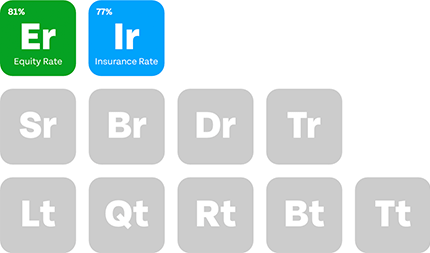Table of Contents
Medical Practice Valuation Calculator
There are several instances where you’ll need a medical practice valuation calculator.
Whether you’re selling, buying, merging, or attracting investors, what matters most is obtaining accurate data to understand the practice’s true position.
In other words, a medical practice valuation shouldn’t be a shallow estimate from a CPA or an enticing offer presented by a PE group looking to acquire your practice.
It should be in-depth enough to help anyone understand what the practice is worth today, why, and what needs to change for it to be worth more tomorrow.
While we’ll discuss the key areas of this concept, it should only be used for educational purposes. To valuate a medical practice, always ensure you contract a professional advisory firm like Physicians Thrive.
Key Takeaways
- Practice valuation is essential for sales, mergers, acquisitions, or attracting investors.
- Key metrics include revenue, EBITDA, expenses, and active patient numbers.
- Common valuation methods are income, market, and asset-based approaches.
- Valuation multiples offer quick estimates but must be contextualized with real data.
Key Metrics for Medical Practice Valuation
Here are a few different ways that we value medical practices for clients.
Revenue Metrics
Revenue metrics are financial indicators that measure how much money a business brings in through its core operations before accounting for expenses, taxes, or other deductions.
These metrics are vital because they form the basis for nearly every standard business appraisal, especially income-based and market-based models (which we’ll discuss later).
Here are the key types of revenue metrics a medical practice should track:
Annual Gross Revenue
This is the total amount your practice collects in a year before expenses are deducted. To spot trends, you’ll often need data from the last three years for valuation.
This clearly shows if your revenue is growing steadily, holding flat, or declining.
Net Operating Income (NOI)
NOI gives a clearer picture of financial performance by subtracting operational expenses from gross revenue. This includes staff wages, rent, utilities, and supplies, but excludes taxes, interest, depreciation, and amortization.
EBITDA
Earnings Before Interest, Taxes, Depreciation, and Amortization (EBITDA) normalizes earnings across different practices by ignoring variables like financing and asset structure. It’s also used to calculate valuation multiples.
Expense Data
While revenue tells you how much is coming in, expense data shows where the money is going and whether it’s being spent wisely. The key components here include:
Overhead Ratio
This is the percentage of revenue spent on operating costs. In a well-run medical practice, overhead typically ranges from 50% to 70%, depending on the specialty.
Higher than that? It might mean bloated staffing, inefficient billing, or poor contract negotiation. Lower? That could mean lean operations, or underinvestment in support staff or tech.
Physician and Staff Compensation
This is usually the largest single expense. It includes salaries, benefits, bonuses, and contractor payments.
When valuing a practice, you need to normalize physician compensation and adjust it to reflect fair market wages.
Operational Costs
Think rent, utilities, EHR Systems, medical supplies, etc. Every dollar spent here should ideally drive growth. If you’re spending heavily in one area without clear benefits, it’s a red flag for inefficiency.
Practice Characteristics
While this is often overlooked, we always highlight how important practice characteristics are and how they can affect your valuation.
Practice characteristics are the non-financial elements that speak to the practice’s identity, patient base, and potential for growth or risk.
Knowledgeable buyers and investors don’t overlook this aspect because two practices with identical financials can have wildly different valuations.
Some practice characteristics to consider during valuation include.
Specialty Type
Specialties directly impact market demand and valuation multiples.
A dermatology clinic, for instance, may have more cash flow and lower overhead than a primary care practice. Surgical specialties, as well, often have higher margins but require more infrastructure and liability coverage.
Location
Urban and suburban areas are often more valuable. These areas often have high population density and strong payer mixes (commercial insurance over Medicaid). Rural practices with little competition and strong patient loyalty can also command higher valuations.
Number of Active Patients
This measures how many patients show up and generate revenue, not just how many are on the books.
Valuation Multiples: What Is It and How Can You Calculate It?
We brought up the concept of valuation multiples several times in this guide; now, we’ll explain what it means for your practice.
Valuation multiples are like shortcuts—they let people estimate the value of a medical practice by comparing it to how similar practices are priced in the market.
Instead of building a complex financial model from scratch, you apply a multiplier to a key financial figure based on industry benchmarks.
It’s like saying, “Practices like this one usually sell for X times their earnings or revenue, so yours probably will too.”
Translating this into a formula: Practice Value = Financial figure × Multiple
Types of Valuation Multiples
-
Revenue Multiple : If a similar practice in your specialty and region sells for 0.6x annual revenue, and you generate $1.2 million, your estimated value is around $720,000. This isn’t always accurate since revenue doesn’t account for profitability, as a practice can have high revenue but razor-thin margins.
-
EBITDA Multiple : Multiples here usually range from 3x to 7x for most practices. Higher-quality practices with recurring revenue and minimal owner dependence can push those numbers higher. Here, Practice Value = EBITDA × Multiple.
-
Per-Patient Value : In cases like membership-based models, you might value a practice by multiplying the number of Active Patients by an average dollar amount. Say $300-$600 per active patient.
Multiples should only be used to get a quick, comparable way to estimate value. However, it shouldn’t be relied upon without proper context of the financial figure used.
Methods for Valuing Your Medical Practice
Asset-Based Valuation
This method values the practice by adding up the worth of its assets and subtracting its liabilities. It’s most appropriate for underperforming or dissolving practices or asset-heavy specialties like radiology or surgical centers.
Asset-based valuation sets a floor value because even if the practice isn’t highly profitable, the physical and digital assets still have resale value.
What’s Included?
- Medical equipment, furniture, and supplies
- Real estate (if owned)
- Accounts receivable
- Intangible assets like patient lists and brand goodwill (harder to quantify but important)
Income-Based Valuation
This method looks at the future cash flow the practice is expected to generate and converts it into present-day value. It’s the gold standard for most serious buyers as it reflects the earning power of the practice.
There are two common models used here.
-
Capitalization of Earnings : Assumes steady earnings into the future. Common for stable, mature practices.
-
Discounted Cash Flow (DCF): Projects future earnings and discounts them to today’s value using a chosen rate. It’s ideal for growing or transitioning practices.
Market-Based Valuation
This method compares the practice to others that have sold recently, just like we explained in valuation multiples.
How It Works
- Identify recent sales of similar practices in the same specialty and region
- Apply valuation multiples (eg, 0.5x revenue or 4x EBITDA)
- Adjust for differences in size, patient base, or overhead.
How Can Physicians Thrive Help You?
Practice valuation shouldn’t be taken for granted, regardless of whether you’re buying, selling, or merging. This is why we’ve not only written this guide to help you understand the concept, but we are also here to walk you through the process.
With decades of combined experience and focus on physician advocacy, we don’t just provide numbers; we give you leverage.
Our team looks beyond surface-level numbers to assess the true value of your practice, factoring in specialty-specific dynamics, patient base strength, revenue consistency, and market positioning.

